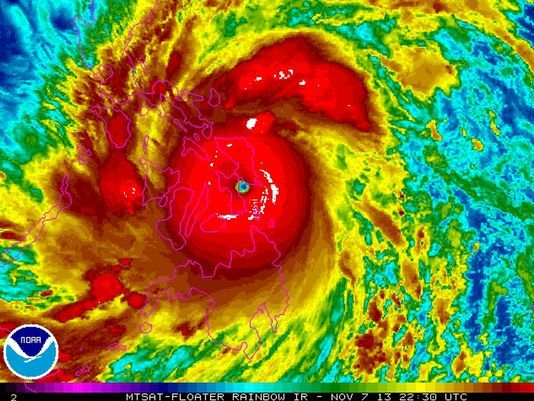 This Thursday, Nov. 7, 2013 satellite image provided by the National Oceanic and Atmospheric Administration shows Typhoon Haiyan over the Philippines. (Photo: Handout via AP)A massive typhoon packing winds approaching 200 mph and called one of the most powerful storms ever recorded blasted into the Philippines on Friday, killing at two people.
This Thursday, Nov. 7, 2013 satellite image provided by the National Oceanic and Atmospheric Administration shows Typhoon Haiyan over the Philippines. (Photo: Handout via AP)A massive typhoon packing winds approaching 200 mph and called one of the most powerful storms ever recorded blasted into the Philippines on Friday, killing at two people.
Forecasters warned of potentially catastrophic damage. Trees were down, power was out in parts of the country, there was widespread flooding and communication with the hardest-hit areas was knocked out.
One man died in southern Surigao del Sur province and another was killed by a falling tree, knocked down by strong winds in central Cebu province, officials said.
Super Typhoon Haiyan made morning landfall at Guiuan, a small city in Samar province in the eastern Philippines. The U.S. Navy's Joint Typhoon Warning Center said maximum sustained winds were 195 mph, with gusts to 235 mph.
It reached the fragile island chain as the most powerful typhoon or hurricane in recorded history, based on wind speed measurements from satellites, says meteorologist Jeff Masters of Weather Underground.
""There aren't too many buildings constructed that can withstand that kind of wind,'' Masters said.
Authorities in Guiuan could not be reached for word of any deaths or damage, regional civil defense chief Rey Gozon told DZBB radio.
Forecaster Mario Palafox with the nation's weather bureau said it had lost contact with its staff in the landfall area.
 Filipino residents sleep on the floor at a gymnasium turned into an evacuation center in Sorsogon City, Bicol region, Philippines, on Nov. 7.(Photo: Kit Recebido, epa)"This is really a wallop,'' Southern Leyte Gov. Roger Mercado said on ABS-CBN television. "All roads are impassable due to fallen trees."
Filipino residents sleep on the floor at a gymnasium turned into an evacuation center in Sorsogon City, Bicol region, Philippines, on Nov. 7.(Photo: Kit Recebido, epa)"This is really a wallop,'' Southern Leyte Gov. Roger Mercado said on ABS-CBN television. "All roads are impassable due to fallen trees."
A reporter for the network in the Tacloban city was drenched in the pounding rain and said he was wearing a helmet as protection against flying debris. Visibility was so poor that only his silhouette could be seen through the driving rain and water.
Television images showed a street under knee-deep floodwater carrying debris. Tin sheets ripped from roofs were flying above the street.
Officials in Cebu province have shut down electric service to the northern part of the province to avoid electrocutions in case power pylons are toppled, said assistant regional civil defense chief Flor Gaviola.
Thousands of people evacuated villages in the central Philippines as Haiyan took aim the region, which was devastated by an earthquake last month.
No Atlantic or eastern Pacific hurricane has ever been stronger than Haiyan (typhoons are the same type of storms as hurricanes).
About 10 million people live on the central Philippine islands and are most at risk from a direct strike from Haiyan.
The latest forecast track shows Haiyan passing near Tacloban, a city of about 250,000, and Cebu, a city of nearly 1 million, reports meteorologist Eric Holthaus ofQuartz magazine.
The storm was not expected to directly hit Manila, which is farther north. Predictions for Manila were for winds of up to 37 mph and rain.
President Benigno Aquino III warned people to leave high-risk areas, including 100 coastal communities where forecasters said the storm surge could reach up to 23 feet. He urged seafarers to stay in port.
"No typhoon can bring Filipinos to their knees if we'll be united," he said in a televised address.
Haiyan is the fourth typhoon to hit the Philippines in 2013, a nation that typically gets hit by more typhoons than any other country in the world, usually about six or seven each year.
Haiyan is the Chinese word for petrel, a type of bird that lives over the open sea and returns to land only for breeding. The storm is known as Super Typhoon Yolanda in the Philippines.
Governors and mayors supervised the evacuation of landslide- and flood-prone communities in several provinces where the typhoon is expected to pass, said Eduardo del Rosario, head of the government's main disaster-response agency. School classes and plane flights were canceled in many areas.
Aquino ordered officials to aim for zero casualties.
Edgardo Chatto, governor of Bohol island province in the central Philippines, where an earthquake in October killed more than 200 people, said soldiers, police and rescue units were helping displaced residents, including thousands staying in small tents, move to shelters. Bohol is not forecast to receive a direct hit but is expected to be battered by strong winds and rain, government forecaster Jori Loiz said.
"My worst fear is that the eye of this typhoon will hit us. I hope we will be spared," Chatto told the Associated Press by telephone.
After roaring across the Philippines, Haiyan is expected to move into the South China Sea and eventually hit Vietnam and Laos over the weekend, still as a typhoon.
 В Атырау -6
В Атырау -6